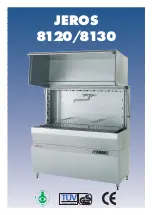
6-6
n
KitchenAid 2013 Stainless Steel Tall Tub Dishwasher
TESTING
For Service Technician Use Only
DANGER
Electrical Shock Hazard
Only authorized technicians should perform
diagnostic voltage measurements.
After performing voltage measurements,
disconnect power before servicing.
Failure to follow these instructions can result in
death or electrical shock.
General Theory of Operation
Refer to Wiring Diagram on page 6-3.
Neutral and L1 (AC voltage) enters the Control Board at P4,
pins 1 & 2 respectively. AC is converted to DC at the LV/HV
Power Supply. LV (Low Voltage) Supplies include 15V, 13V, 5V,
and 3.3V DC. These LV supplies are used to provide power
to the microprocessors and board components, control the
triacs, power the sensors, buzzer, fan motor, and energize the
AC relays. The 170V DC HV (High Voltage) Supply is used to
control the variable speed wash and drain motors.
The 13V DC is vital to the operation of the dishwasher.
This supply is necessary to operate all 120V AC loads in
the dishwasher, whether they are connected to a relay or
controlled by triacs. 13V DC is generated by the power supply
and flows through the door switch—when closed—to be
available to the heater relays, wash & drain motor relays,
and the pilot relay. A relay coil becomes energized when
the control closes the LV drive circuit for a specific relay
completing 13V pathway, which in turn closes the relay switch
providing AC to the load. The Pilot relay provides “L1” to
the remainder of the components that are controlled by the
Neutral-sensed triacs.
There are three fuses on the Control Board: the L1 Fuse, the
Motor Fuse, and the Triac Fuse. If the L1 Fuse is open, the
entire dishwasher is unresponsive. If the Motor Fuse is open,
both variable speed wash and drain motors will not operate.
And, if the Triac Fuse is open, all loads controlled by Triacs will
not operate.
NOTE:
Refer to “Fuse Service and Diagnostic Checks” on page
6-4.
Power Check
This test checks for incoming and outgoing power to and from
the control board. This test assumes that proper voltages is
present at the outlet or direct connect cable.
Test Procedure
1. Unplug dishwasher or disconnect power.
2. Remove access panel.
3. Remove terminal box cover.
4. With a voltmeter set to AC, insert black probe inside white
wire screw nut (N) and insert red probe inside black wire
screw nut (L1).
5. Plug in dishwasher or reconnect power.
¾
If 120V AC is present, unplug dishwasher or disconnect
power and proceed to step 6.
¾
If 120V AC is not present, have customer correct power
problem at outlet or breaker.
6. Remove outer door panel.
7. Remove cover from control board and locate connector P4.
8. With a voltmeter set to AC, connect black probe to P4, pin
1 (N) and red probe to P4, pin 2 (L1).
9. Plug in dishwasher or reconnect power.
¾
If 120V AC is present, go to step 10.
¾
If 120V AC is not present, check for open connection
between terminal block and control. Repair as needed.
10. Verify DC Supplies
• +3.3 & +5V DC
is used to power IC’s and micro-processors
on the circuit board and also provide power to the fan
motor and sensors.
¾
If +
3.3V DC
were missing, the dishwasher would
become unresponsive. To 3.3V ± 5%, with a
voltmeter set to DC, connect the black lead to P12-2
(GND) and the red lead to P11-2 (+3.3V).
¾
If
+5V DC
were missing, the fan motor or diverter
switch would not function. To 5V ± 5%, with a
voltmeter set to DC, connect the black lead to P12-2
(GND) and the red lead to P10-5 (+5V).
• +13V DC
is used to actuate most of the 120V AC relays and
triacs on the control.
¾
If
+13V DC
was missing, the heater, motors, and all
other loads would not turn on. To 13V ± 5%,
with a voltmeter set to DC, connect the black lead to
P12-2 (GND) and the red lead to P9-6 (+13V).
Troubleshooting Missing DC Supplies:
Refer to the
wiring diagram on page 6-3 when troubleshooting the
DC supplies. If +3.3, +5, or +13V DC is missing on the
control, unplug dishwasher or disconnect power, and then
disconnect all components/loads from the control relying
on the missing or loaded supply. Plug in dishwasher or
reconnect power and check if the DC supply has returned.
¾
If not, replace the control.
¾
If it has, turn off dishwasher and reconnect one
connector at a time until the component loading down
that supply has been identified.
11. Unplug dishwasher or disconnect power.
12. Reassemble all parts and panels.















































